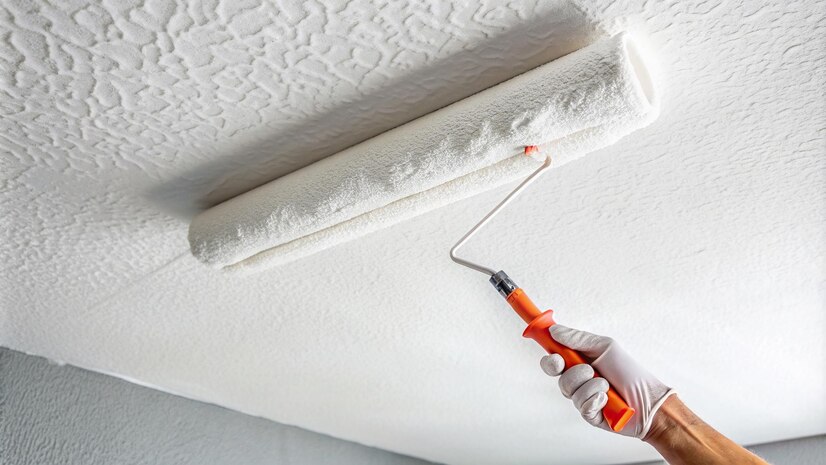Ceiling paint can dramatically alter the look and feel of a room, making it essential to choose the right one based on your space’s unique characteristics. Interior room remodeling was the most frequent project carried out by U.S. homeowners who renovated their property in 2023, highlighting the importance of thoughtful design choices. When painting ceilings, interior painters in Westport, CT, emphasize that factors such as room height, color selection, and finish play a vital role in creating the perfect ambiance.
6 Expert Tips from Interior Painters for Choosing the Perfect Ceiling Paint
1. Assess Room Height
One of the first steps to choosing the perfect ceiling paint for any room is assessing the room’s height. This will influence the paint’s finish, color, and even the overall look of the space. Interior painters recommend following a few key guidelines to ensure you select the best ceiling paint based on the height of the room.
Measure the Ceiling Height
Interior painters recommend measuring the ceiling height before making any decisions about paint. Here’s how to do it:
-
- Use a Tape Measure: Begin by using a tape measure to determine the height from the floor to the ceiling. This measurement will give you the base information you need to move forward.
-
- Mark the Height: Interior painters suggest writing down the height and marking it on a floor plan of your space if possible. This will help keep your design and painting plans organized.
-
- Check for Variations: Don’t assume all rooms have the same ceiling height. Interior painters advise checking each room individually, especially in older homes, where ceiling heights may vary.
2. Match Paint Finish to Room Height

When selecting paint finishes, interior painters emphasize that ceiling height plays a crucial role in determining the best finish for a room. Choosing the right paint finish can dramatically impact how the room feels, and it’s essential to match it appropriately to the room’s ceiling height.
Choose Flat/Matte Finish for Tall Ceilings
Interior painters recommend opting for a flat or matte finish when dealing with tall ceilings. These finishes absorb light rather than reflecting it, which helps create a more balanced and cohesive look in rooms with higher ceilings. Here’s why matte finishes work for tall ceilings:
-
- Minimizes glare and softens the room’s appearance
-
- Conceals imperfections and uneven textures
-
- Offers a smooth, elegant look
Opt for Satin or Eggshell Finish for Medium to Low Ceilings
For rooms with medium to low ceilings, interior painters recommend considering satin or eggshell finishes. Here are some key benefits of satin/eggshell for lower ceilings:
-
- Reflects more light, enhancing the sense of space
-
- Provides a slightly polished look without being too shiny
-
- Easy to clean, making it ideal for frequently used rooms
3. Pick the Right Paint Color
Selecting the right color for your ceiling is a critical decision that can greatly influence the mood, perception of space, and overall ambiance of a room. Interior painters stress the importance of considering both the height of the ceiling and the room’s purpose when choosing your ceiling color. The proper selection can either make the ceiling feel closer for a cozy effect or visually raise it to create a sense of openness.
Go Darker for Higher Ceilings to Create Intimacy
For rooms with higher ceilings, interior painters often recommend using darker colors. Darker shades such as deep blues, charcoal, and rich earth tones add a sense of intimacy and warmth to large spaces that might otherwise feel vast or impersonal.
By visually bringing the ceiling down, darker tones help to make the room feel more inviting and comfortable. This technique is particularly effective in spaces like living rooms, dining rooms, and formal spaces where a more dramatic and cozy atmosphere is desired.
Stick to Lighter Shades for Low Ceilings to Enhance Openness
On the other hand, for rooms with lower ceilings, interior painters recommend sticking to lighter shades. Light colors, such as soft whites, creams, and pale pastels, reflect more light and can help make the ceiling feel higher. This opens up the room, creating a sense of airiness and making the space feel larger and more welcoming.
4. Test Paint Swatches on Ceilings

Choosing the right ceiling paint involves testing the paint in your actual space. Interior painters recommend applying swatches directly to the ceiling at various heights and in different lighting conditions. This method ensures that you see how the color behaves in your specific room before making a final decision.
Try Samples at Different Heights
The perception of color can shift based on the height and architecture of the room. Interior painters emphasize that applying swatches in strategic areas will give you a more accurate representation of how the color will look once fully applied to the ceiling. Here’s how interior painters recommend approaching this step:
-
- High Points: For rooms with vaulted or tall ceilings, test the paint near the higher sections of the ceiling. This is crucial because, at greater heights, colors might appear lighter due to the distance from the eye and the way light diffuses across the surface. Darker shades may soften, while lighter colors could blend into the background.
-
- Low Points: Apply swatches closer to the walls to see how the ceiling color contrasts with the rest of the room. In rooms with lower ceilings, this is particularly important, as the color may appear more saturated and intense. Interior painters suggest doing this in corners and near windows to get a sense of how light and shadows will play off the paint.
-
- Unique Features: Test the paint around architectural features such as ceiling beams, skylights, or sloped ceilings. Interior painters recommend this approach to observe how the color interacts with different elements, like shadows cast by beams or the natural light coming through a skylight. This ensures that your ceiling color works well with the room’s unique features.
Observe How Lighting Affects Color Perception
-
- exposure tend to bring out cooler tones in paint. Interior painters recommend observing how natural morning light affects your swatches, particularly in bedrooms and living rooms where morning light is prevalent. Cool grays and blues may feel more pronounced during this time of day.
-
- Afternoon Light: As the day progresses and sunlight becomes more direct and neutral, interior painters suggest checking the swatches during midday. This is when the paint color will appear most balanced and neutral, without the influence of strong sunlight or shadows. Afternoon light can soften colors, especially in rooms with west-facing windows or those that receive steady indirect light throughout the day.
-
- Artificial Light: Ceiling paint can appear quite different under artificial lighting. Interior painters recommend testing your swatches under the room’s primary light sources, such as ceiling fixtures, lamps, or recessed lights. The warmth or coolness of artificial light bulbs (whether LED, incandescent, or fluorescent) can alter the hue of the paint. Warmer lights might enhance beige, yellow, or warm gray tones, while cooler lights can bring out blue, green, or violet undertones.
5. Factor in Ceiling Texture
Ceiling texture plays a significant role in determining the best paint finish for your space. The texture of the ceiling, whether rough or smooth, impacts how light is absorbed or reflected, which ultimately affects the room’s overall appearance. Interior painters emphasize that selecting the appropriate finish based on the texture of your ceiling is key to achieving a polished and cohesive look.
Use Flat Paint for Textured Ceilings

For ceilings with texture—such as popcorn, knockdown, or other uneven finishes—interior painters recommend using flat or matte paint. Flat paints are particularly effective because they do not reflect much light. This low reflectivity helps to mask imperfections, inconsistencies, and shadows that are often present in textured ceilings. As a result, flat finishes create a more uniform and subtle appearance, allowing the texture to serve as a design element without drawing unwanted attention to flaws.
Interior painters often choose flat paint for textured ceilings in older homes or spaces where the ceiling may have been damaged or unevenly finished. It’s a practical choice for maintaining a clean, understated look.
Choose Semi-Gloss for Smooth Ceilings
On the other hand, if your ceiling is smooth, interior painters recommend opting for a semi-gloss or satin finish. These finishes reflect more light, giving the ceiling a slight sheen that makes the space feel brighter and more spacious. Semi-gloss finishes are perfect for smooth ceilings in modern or contemporary homes where you want to enhance the sleekness and create a more polished look.
Interior painters particularly recommend semi-gloss finishes for low ceilings or in rooms where you want to maximize the sense of space. This finish is ideal for kitchens, bathrooms, or small rooms where brightness is a priority and where the reflective qualities of the paint can make the ceiling appear higher.
6. Final Tips for Painting Ceilings
Interior painters emphasize that preparation is key to a successful paint job. Ensuring the room is properly prepped will not only save time but will also result in a more professional finish.
-
- Cover Furniture and Floors: Use drop cloths or plastic sheeting to protect surfaces from paint splatter.
-
- Clean the Ceiling: Interior painters recommend cleaning the ceiling thoroughly to remove dust, cobwebs, and stains that could interfere with paint adhesion.
-
- Tape Off Edges: Applying painter’s tape along the edges of the ceiling will help achieve clean, crisp lines when transitioning from ceiling to walls.
Use the Right Tools for Even Coverage
Having the right tools on hand can make a significant difference in achieving even, streak-free coverage. Interior painters suggest investing in quality brushes and rollers for the best results.
-
- Rollers for Smooth Ceilings: Use foam or short-nap rollers for smooth ceilings to ensure an even coat.
-
- Rollers for Textured Ceilings: For textured ceilings, interior painters recommend thicker nap rollers that can adequately cover rough surfaces.
-
- Brushes for Edges: Use angled brushes to cut in around the edges for precise application where the roller cannot reach.
Apply a Second Coat for Durability and Smoothness
For a lasting and professional finish, interior painters always advise applying a second coat of paint. The second coat enhances the paint’s durability, helps achieve full color saturation, and smooths out any inconsistencies.
-
- Better Coverage: Interior painters explain that the second coat fills in areas where the first coat might have been uneven.
- Increased Durability: Adding a second coat ensures the paint withstands wear and tear, especially in high-traffic areas like kitchens or living rooms
Frequently Asked Questions
How long does it take to paint a ceiling?
The time it takes to paint a ceiling depends on the size of the room and the level of preparation needed. On average, a standard room with minimal repairs may take between 4 to 6 hours, including preparation, painting, and cleanup. Larger rooms or spaces with high or textured ceilings may require additional time. Factors such as drying time between coats or complex repairs can also extend the duration of the project.
Is it necessary to hire a professional interior painter for ceilings?

While it is possible to paint a ceiling yourself, many people choose to hire a professional due to the unique challenges involved. Painting a ceiling can be physically demanding, requiring extended periods of working overhead, which can cause neck and shoulder strain. Professionals also have the necessary tools, like specialized rollers and scaffolding, to complete the job more safely and efficiently. In addition, a skilled painter can achieve a smooth finish with fewer mistakes, ensuring the final result is free of streaks or uneven areas.
What are the most common mistakes when painting a ceiling?
One common mistake is not properly preparing the surface, which can lead to poor paint adhesion or visible imperfections. Skipping primer, especially on stained or previously unpainted ceilings, can result in uneven coverage. Another mistake is using the wrong type of paint, such as a glossy finish, which can highlight imperfections rather than hiding them. People also tend to underestimate the importance of using the right tools, like quality rollers designed for ceilings, which can prevent drips and provide smoother application. Additionally, applying too much paint at once can lead to drips and streaks, making the ceiling look uneven.
How often should ceilings be repainted?
Ceilings generally do not require frequent repainting compared to walls, as they are less likely to be damaged by everyday activities. In most cases, ceilings need to be repainted every 7 to 10 years, or when noticeable discoloration, stains, or cracking occurs. Ceilings in high-humidity areas like bathrooms or kitchens may need to be painted more often due to moisture and potential mildew. If a ceiling develops water stains or peeling paint, it’s important to address the underlying issue before repainting.
How long does ceiling paint take to dry?
Ceiling paint typically takes anywhere from 1 to 2 hours to dry to the touch, but this can vary depending on several factors such as the type of paint used, the room’s humidity, temperature, and ventilation. Water-based (latex) paints generally dry faster, often becoming touch-dry within an hour, while oil-based paints can take longer, up to 6 to 8 hours. However, drying to the touch does not mean the paint is fully cured. Complete curing can take anywhere from 24 hours to a few days, during which time the paint reaches its full hardness and durability. It’s recommended to wait at least 4 to 6 hours between coats and avoid significant handling or contact for a day or more to ensure the best results.
Achieve Flawless Ceilings with Expert Interior Painting in Westport, CT!
At Custom Colonial Painting, we understand how important it is to choose the right ceiling paint for your unique space. Whether you’re dealing with high ceilings that need a cozier touch or smooth surfaces that need a modern finish, our team of experienced interior painters in Westport, CT, is here to help. Let us handle the details so you can enjoy beautifully painted ceilings that enhance your home’s atmosphere. We are committed to delivering exceptional quality and craftsmanship in every project.



